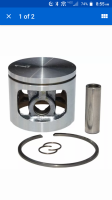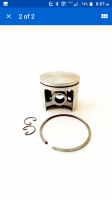There seems to be a consensus here that quad ports require more blow down than dual port. Delete this if I throw too much out there, but is it because the quad ports are closer to the exhaust port and would scavenge too much from the transfers? I would have to link 2 things that contribute to determining the amount of blow down..... 1) the distance between the exhaust port and transfers and 2) the angle that the transfer ports favor forcing the air-charge into the cylinder. It would all be relative to how much air-charge would be lost out of the exhaust port.
So a quad port would benefit from an angle that would direct the air-charge more to the rear of the cylinder......if it is indeed closer to the exhaust port. Continuing on that theory, a transfer port close to the exhaust port may also benefit with a reduced window size, or a tapper that would increase the velocity in that area projecting the air-charge away from the exhaust port. While other transfer ports at the rear of the cylinder could be of a design with a lower velocity. However, it would be necessary to have the transfers closer to the exhaust open first and close last to keep the air-charge from the rear transfers in the cylinder for combustion.
Or am I an idiot?











